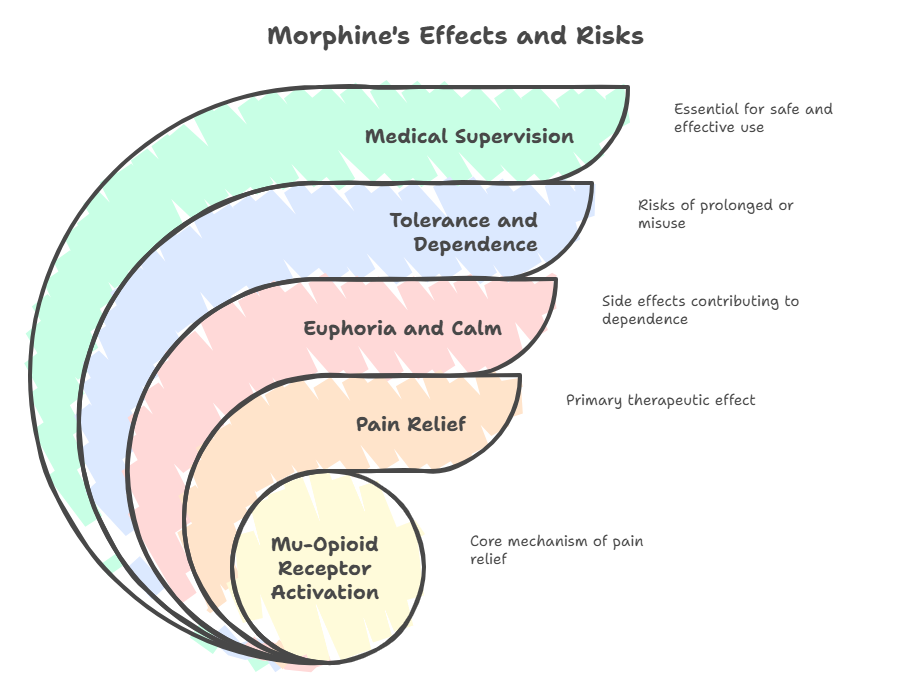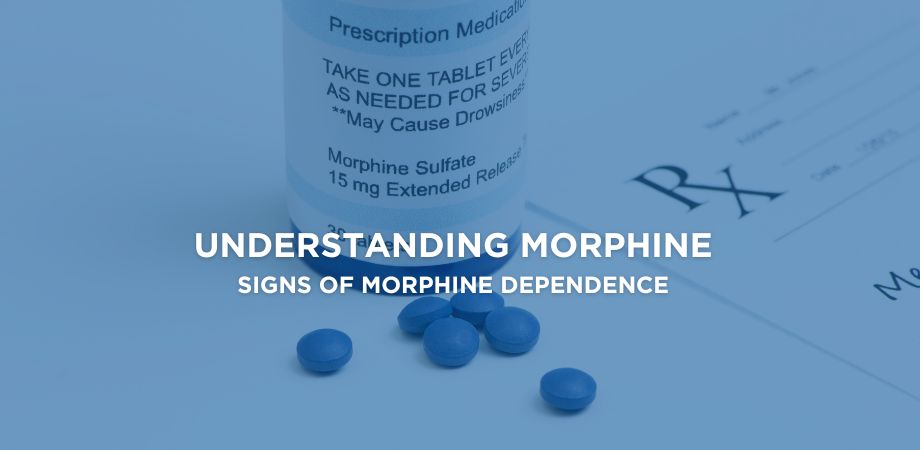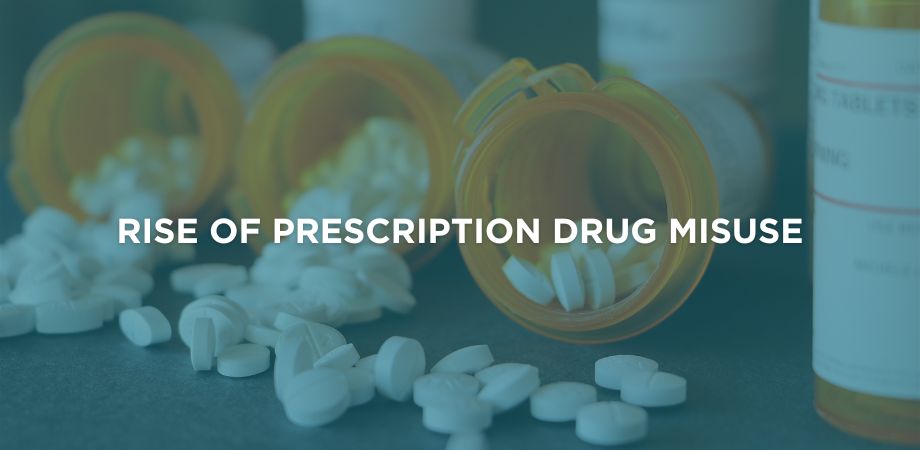Morphine is one of the most effective pain-relieving medicines used in hospitals and clinics across India. Derived from the opium poppy, it belongs to the opioid family; drugs that work directly on the brain to ease severe pain. While morphine offers comfort to those suffering from chronic or post-surgical pain, its powerful effects also make it one of the most addictive prescription medications when misused or taken for long durations.
This article explores the fine balance between therapeutic use and the risk of addiction. It explains how morphine addiction develops, the signs and symptoms to watch for, and the risk factors that increase vulnerability, including mental health challenges, prolonged use, and lack of prescription monitoring. You’ll also learn about safe use practices, treatment options, and ways to prevent misuse, supported by credible research and real clinical insights.
Understanding morphine’s addictive potential isn’t just for medical professionals; it’s vital for patients and families too. Awareness helps identify early warning signs and encourages timely action before dependence takes hold. Let’s dive deeper into this article to learn more about it.
What Is Morphine?
Morphine is a powerful opioid analgesic derived from the opium poppy plant (Papaver somniferum). It has been used in medicine for more than a century to relieve moderate to severe pain, especially in conditions like post-surgical recovery, serious injury, and advanced-stage cancer.
Doctors prescribe morphine when other painkillers fail to provide relief. It helps reduce suffering, improves rest, and enhances quality of life, particularly in palliative and cancer care. However, because of its potency, morphine must always be used under strict medical supervision.
Morphine works by binding to mu-opioid receptors (MORs) in the brain and spinal cord, blocking pain signals and increasing dopamine release. This dual action reduces pain while creating a sense of calm or mild euphoria: a combination that can lead to tolerance and dependence when misused.
A clinical research study from StatPearls (NCBI, 2024) confirms that morphine acts primarily through mu-opioid receptor activation, explaining both its effectiveness and its risk for dependence.
Used responsibly, morphine is life-changing for patients in pain. However, its misuse can lead to dependency, requiring careful oversight and medical education.

Can Morphine Be Addictive?
Morphine sits among the most powerful painkillers in modern medicine. But that strength carries a dark side: a very high risk of addiction, owing to its opioid nature.
Why Morphine Has High Addiction Potential?
Morphine acts directly on µ-opioid receptors in the brain and spinal cord. Over time, repeated activation rewires reward circuits.
- Chronic use leads to tolerance (needing more drug for the same effect) and dependence (brain adapts to its presence).
- As control falters, compulsive urges and drug-seeking take over. That shift from controlled medical use to compulsive use is core to addiction.
To sum it in simple terms: morphine is a medicine, but it also hijacks the brain’s reward center in ways many people underestimate.
Physical Dependence vs. Psychological Addiction
These two terms are often used interchangeably, but they are not the same.
Term | Definition | Key feature | Reversibility |
Physical dependence | The body adapts so that stopping morphine leads to withdrawal symptoms | Mainly bodily and autonomic symptoms (e.g., sweating, tremors, diarrhea) | Can develop even under supervised medical use; reversed by tapering |
Psychological addiction | A brain disease where the user loses control over use, despite harm | Cravings, compulsive use, loss of control | More complex; requires behavioral, medical interventions |
- Physical dependence is a predictable, treatable adaptation seen in many long-term opioid users.
- Psychological addiction involves changes in brain circuits of reward and decision-making. The user prioritizes drug use over health, family, or work — even when suffering consequences.
A patient might have physical dependence without addiction (for example, in palliative care), but with misuse or escalation, addiction can develop.
How Misuse Begins?
Several patterns commonly lead a person from legitimate use to misuse or addiction:
- Non-medical use
Someone might start taking morphine not for pain, but to feel its “high” or to cope with stress or emotional pain. - Dose escalation
Tolerance builds, so a user increases dose to chase the original effect. That increases risk drastically. - Using someone else’s prescription
Taking morphine that was prescribed to someone else, especially in higher amounts, bypasses medical supervision. - Switching to faster delivery routes
For example, crushing extended-release pills to inject or snort them. The faster onset strengthens addictive potential. - Self-medicating withdrawal or emotional distress
Once dependence sets in, a user may take morphine just to feel “normal” or to avoid withdrawal rather than for pain. - Polydrug use
Combining morphine with other depressants or stimulants to intensify effect or manage side effects.
These paths don’t all lead to addiction in every case, but they raise the chance significantly, primarily when emotional, social, or psychiatric vulnerabilities exist.
Why Some People Are More Vulnerable”
- Genetic variations (in opioid receptors or metabolic enzymes)
- Past exposure to trauma, stress, or psychiatric illness
- Lack of social support or an environment that tolerates drug use
- Pain conditions that lead to prolonged opioid prescriptions
These vulnerabilities make otherwise controlled use more dangerous.
Signs and Symptoms of Morphine Addiction
Recognizing the signs of morphine addiction early can save a life. Mostly people begin using morphine for pain, but the line between prescribed use and addiction blurs fast. What starts as relief often turns into craving, secrecy, and dependency. These symptoms affect the body, mind, and behavior. Knowing these red flags helps families, caregivers, and the person themselves take timely action and seek help before the addiction takes full control.
Physical Symptoms
The body sends early distress signals when morphine use turns problematic. These are not just side effects; they reflect the body’s dependence on the drug.
Key physical signs include:
- Drowsiness or sedation, often at odd hours.
- Slowed breathing or shallow respiratory rate.
- Constricted pupils, even in low light.
- Dry mouth and nausea that don’t ease easily.
- Constipation or irregular bowel habits.
- Sudden weight loss and lack of appetite.
- Reduced physical energy and chronic fatigue.
When these symptoms persist or worsen, they may signal that the body has adapted to constant opioid exposure.
Psychological and Behavioral Signs
Morphine addiction doesn’t just affect the body; it reshapes thoughts, moods, and relationships. The emotional toll often drives users deeper into isolation.
Common psychological and behavioral signs include:
- Frequent mood swings, from euphoria to deep sadness.
- Irritability or anxiety when morphine isn’t available.
- Social withdrawal, avoiding friends or family gatherings.
- Neglecting personal hygiene or daily self-care.
- Secretive behavior, hiding use or lying about dosage.
- Loss of interest in hobbies, work, or responsibilities.
- Denial of addiction, despite clear physical signs.
When these behavioral shifts appear, they often mark the transition from controlled use to psychological addiction.
Clinical Evidence from India
A 2021 study published in the Indian Journal of Palliative Care examined patients on long-term morphine therapy (≥ 12 months, ≥ 60 mg/day). Researchers found that nearly 32% showed behavioral symptoms such as secrecy, irritability, and social isolation, while 24% exhibited physical dependence, including tolerance and withdrawal signs. The authors concluded that early behavioral shifts often precede visible physical dependence, highlighting the importance of early recognition and family awareness.
Risk Factors for Morphine Addiction
Morphine can help manage severe pain, but certain risks make addiction more likely in some people than others. Knowing them helps in prevention and early action.
1. Factors Increasing Addiction Risk
- Prolonged use: Using morphine continuously for months or years increases tolerance and dependence.
- High-dose prescriptions: Stronger doses raise the stakes, the body adapts faster.
- History of substance abuse: Past addiction to alcohol, tobacco, or other drugs heightens vulnerability.
- Mental health disorders: Depression, anxiety, PTSD or other disorders often co-occur, making misuse more likely.
- Genetic predisposition: Some genes influence how the brain responds to opioids.
- Chronic pain conditions: Longstanding pain drives repeated use, risking escalation.
- Social or environmental stressors: Poverty, trauma, peer influence, or low social support can push someone toward misuse.
2. Role of Prescription Access and Monitoring
When morphine is easy to access without oversight, risk increases. Weak controls let people:
- Obtain large quantities or refills too soon
- Doctor-shop across clinics or hospitals
- Share or sell leftover medicine
A recent U.S. study found that co-prescribing benzodiazepines or gabapentinoids with opioids increased the risk of developing opioid use disorder by 16–46%. This shows that prescription practices and monitoring systems are crucial in preventing misuse.
3. Dangers of Combining Morphine with Other Substances
Mixing morphine with other depressants magnifies danger. Respiratory depression, overdose, and fatality risks rise sharply.
- Benzodiazepines + opioids: These together significantly increase mortality risk. Different studies showed long-term combined use raises death risk more than either alone.
- Alcohol + opioids: Alcohol amplifies central nervous system (CNS) depression, increasing the chance of breathing failure.
- Other sedatives or sleep medications: Adding them further clouds judgment and slows breathing.
- The FDA warns that combining opioid pain medicines with benzodiazepines can result in life-threatening side effects, including profound sedation, respiratory depression, coma, or death.
In short, combining morphine with other depressants is one of the most dangerous mistakes in misuse.
Managing and Preventing Morphine Addiction
Morphine can be a lifeline for people in severe pain, but misuse can quickly turn it into a threat. The best way to prevent morphine addiction is by using it responsibly under medical supervision and with full awareness of its risks.
1. Importance of Strict Adherence to Prescribed Guidelines
Always take morphine exactly as prescribed. Never increase the dose, even slightly, without consulting a doctor. Following dosage schedules strictly prevents tolerance and dependency from forming.
Doctors prescribe morphine after carefully assessing pain levels, body weight, and past medical history. Ignoring these limits or using someone else’s prescription can make the body dependent in just a few weeks.
2. Strategies for Safe Use
Safe use begins with open communication and accountability.
- Regular medical check-ins: Visit your doctor often to review dosage, pain levels, and any withdrawal symptoms.
- Use the lowest effective dose: If pain is manageable, taper down under medical advice.
- Avoid self-adjusting doses: Even one unapproved increase can trigger dependency.
- Secure storage: Keep morphine locked away to prevent accidental or unauthorized use.
- Never mix substances: Avoid alcohol, sedatives, or sleeping pills unless your doctor approves.
These strategies help reduce the brain’s exposure to opioids, lowering the chance of addiction while still managing pain effectively.
3. Steps to Take if Addiction Is Suspected
If you or someone you love shows signs of misuse like craving, doctor shopping, or mood swings, seek help immediately. Start with a medical evaluation or an addiction assessment from a licensed professional.
Treatment may involve detox, therapy, and rehabilitation in a specialized center like Alpha Healing Center, where recovery focuses on both physical healing and emotional balance.
Early recognition and prompt action can turn dependence into recovery before it becomes destructive.
Treatment Options for Morphine Addiction
Treatment for morphine addiction focuses on detoxifying the body, retraining the mind, and rebuilding daily life. The process begins with an assessment by medical professionals to understand the level of dependence and any co-existing issues like depression or anxiety.
A combination of medical detox, behavioral therapies, and aftercare support forms the foundation of long-term recovery. At this stage, continuous monitoring ensures that withdrawal is safe and manageable.
Role of Medical Detox and Supervised Tapering
Medical detox is the first critical step. It helps clear morphine from the body while minimizing withdrawal symptoms such as anxiety, muscle pain, or restlessness.
Doctors may use supervised tapering, where the dose is gradually reduced instead of being stopped suddenly. This method prevents severe withdrawal reactions and keeps the process medically safe.
At Alpha Healing Center, the medical team uses personalized detox plans crafted by experienced doctors, psychologists, and wellness experts. Continuous monitoring, round-the-clock nursing care, and evidence-based withdrawal management help each client move through detox safely and comfortably.
3. Support Options After Detox
Once detox is complete, real recovery begins. Ongoing support helps prevent relapse and rebuild a healthy, substance-free lifestyle.
Key support options include:
- Medication-Assisted Treatment (MAT): Drugs like buprenorphine or naltrexone reduce cravings and help maintain stability.
- Psychological therapy: Cognitive Behavioral Therapy (CBT) and Motivational Enhancement Therapy help individuals understand and change addictive patterns.
- Support groups: Sharing experiences in groups like Narcotics Anonymous builds confidence and accountability.
- Family counseling: Involves family members to restore trust and communication at home.
At Alpha Healing Center, these approaches come together through a holistic, client-centered program. Our team not only treats addiction medically but also heals emotional wounds through yoga, mindfulness, and psychotherapy, helping clients reconnect with life, family, and purpose.
Every patient is guided by a multidisciplinary team that treats addiction with compassion and clinical excellence. Our mission is simple: to help your loved one recover, restore balance, and rediscover peace.
Myths and Facts About Morphine Addiction
Many people still believe morphine addiction is rare or only happens to those who misuse the drug intentionally. In truth, addiction can develop quietly, even under medical use. Breaking these myths is key to encouraging early help and reducing stigma.
Common Myths vs. Facts
- Myth: Prescription drugs like morphine are always safe.
Fact: Morphine is safe only when taken exactly as prescribed. Misuse or prolonged use can quickly lead to dependence. - Myth: Addiction is a moral failure or lack of willpower.
Fact: Addiction is a medical condition that alters brain chemistry and needs professional treatment, not judgment. - Myth: You can stop morphine anytime if you really want to.
Fact: Sudden withdrawal can cause severe symptoms. Safe recovery requires medical detox and supervision. - Myth: Only people with weak character become addicted.
Fact: Anyone, regardless of background, can develop addiction under stress, pain, or prolonged exposure.
Breaking these misconceptions helps families approach morphine addiction with empathy and understanding. At Alpha Healing Center, treatment focuses not only on recovery but also on restoring dignity, breaking stigma, and rebuilding a life free from shame and dependence.
Conclusion
Morphine is a powerful medicine, but its misuse can quickly lead to dependence and addiction. Using it responsibly, only under medical supervision, is the safest way to manage pain without risking harm.
If you or someone you love shows signs of morphine misuse, seek professional help immediately. Early intervention makes recovery easier and lasting.
At Alpha Healing Center, our expert medical team provides compassionate, evidence-based care to help individuals break free from addiction and rebuild their lives.
Reach out today to begin the journey toward healing, balance, and a drug-free future.





